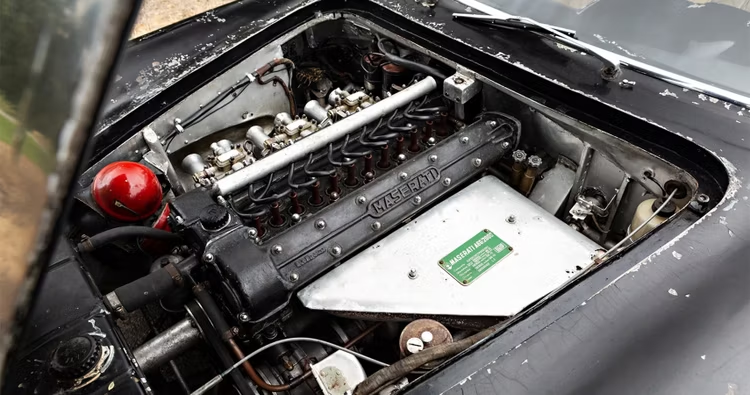Here’s Why Car Collectors Are Furious About This Million-Dollar Maserati Barn Find Restoration
- Mainly Motoring
- Jul 31, 2023
- 4 min read
Updated: Aug 1, 2023
While some see the restoration of this ultra-rare Italian classic GT as a positive, others see its resurrection as sacrilegious. And here’s why.
BY SAM MAIN
VIA HOTCARS
PUBLISHED APR 14, 2023

The story of restoring a barn find is not so uncommon these days. But when a truly special vehicle is found it can be a truly enthralling feeling for enthusiasts to know that a classic will be brought back to life. No doubt this was the case for Jonathan Segal, a San Diego-based architect, who uncovered a piece of Italian automotive history when he acquired a 1956 Maserati A6G/54. A car so beautiful and timeless in its design that many consider it to be an all-time classic car, and rightly so when you simply look at it.
Segal – who is the current owner of the Pietro Frua coach built classic – is aiming to restore the ’56 Maserati to its former glory. However, while some have praised such a decision, others have directed criticism at Segal and the car community at large for restoring what are historical timepieces. But why are various car collectors displaying anger towards Segal for wanting to bring this classic Maserati back to life? The answer is sure to spark debate.
The Maserati A6G/54 Is An Exclusive Grand Tourer

Before such a question can be answered, an overview of this Italian classic is warranted to get a full picture of the situation. The 1956 Maserati A6G/54 was an exclusive grand touring machine built to display the craft, design, and engineering skills that the Maserati team harbored during post-war Europe. It was a coach built, drop-dead gorgeous vehicle that had race car origins from the Maserati A6GCS, but was comfortable enough to go jet-setting off to the South of France or the Italian lakes. No surprise given the luxury tenets that underpin the Maserati brand.

Its smooth inline-6 powertrain produced 160 hp and would redline at 7000 rpm. Thanks to its peppy engine and lightweight figure of 1852 lbs, the A6G/54 could reach a top speed of 130 mph; impressive for a vehicle made in the ‘50s. But speed and agility were not the key features of the Zagato-designed Maserati. It was about exclusivity and luxury, given that only 60 units were ever produced, and its interior was a spacious and comfortable place to be. It’s safe to say that anyone today who acquires such a vehicle is in for a truly special experience.
The Backlash Against Restoring The Italian Barn Find
Evidently, the A6G/54 was a specially designed and crafted Italian classic. A car that would provide an experience like none other and one that demonstrates Maserati's reputation for creating some of the most beautiful cars to ever grace the road. So when Segal discovered his A6G/54 being auctioned off (after the car had been in a barn for 20 years), it’s entirely understandable why one would yearn to buy it. Over $2 million later, chassis number 2140 belonged to Segal.
The start of the ownership experience, similar to the honeymoon phase of a relationship, was rather pleasant. After getting the Maserati home and a full service had been done to the car, it started and drove right away. Incredible for a car that had been sitting in a barn for over 2 decades. But after driving it around California and entering car shows and events with it, the condition of the A6G/54 began to deteriorate at a tremendous rate. Paint began to fall off, there was more rust than metal, the list continued. Something needed to be done.

Segal decided to do a nut-and-bolt restoration on the Italian classic, taking the car down to bare metal and building it back up, resurrecting it. However, as was hinted earlier, this was met with considerable backlash. Some claimed that restoring the Maserati was destroying history, ruining the car as a historical artifact. Others argued that taking the Italian GT down to bare metal was like ‘erasing an Old Master’ in terms of the work done by the Maserati engineers back in the ‘50s. One such critic, Tom Hale, a proponent of cars being drivable forms of artwork, even argued that restoring classics such as the Maserati is ‘obliterating [the] preservation, [the] originality’ of the vehicle itself.
The Future Of The Beautiful Maserati Classic Car

Whether these arguments have any merit is yet to be determined. The topic of restoring classics and whether petrol heads should engage in such activity will forever remain a datable issue. What’s clear though is that the restoration of barn finds can often give a new lease of life to often neglected cars, with some fetching over 7 figures at auctions if rejuvenated and, like Lazarus, is brought back from the grave. While some will reject the idea of restoring such classics in an effort to preserve their heritage, others will welcome it to allow people of today to witness – with their own eyes – drivable works of coach-built art.
For Segal, the criticism directed at him is purely noise. The A6G/54 will be restored and improved, and he aims to enjoy the car once more on the road whilst entering it into future competitions to hopefully bag another award. With classic Maserati’s now appreciating in value, Segal’s A6G is both a stable investment asset and a picturesque poster poser. A car so beautiful, heads will turn in unison. A car so focussed on luxury and grand touring; a simple commute is transformed into a sensational drive. Suddenly, restoring this classic car makes all the sense in the world.






Comments